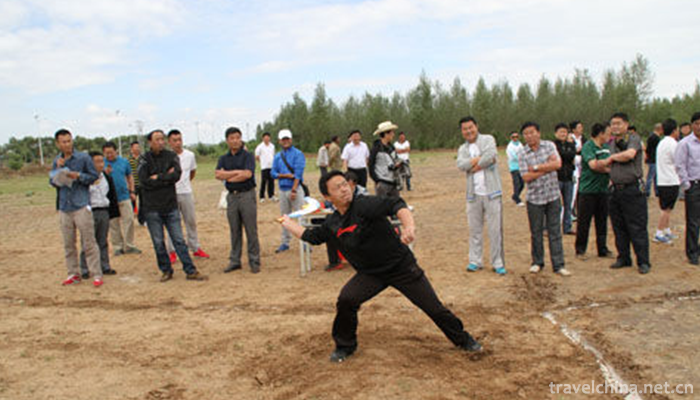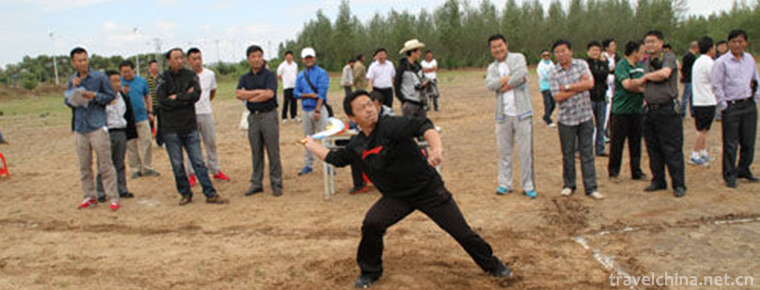Bru
Bru
Bru, Mongolian means throwing. Competitions are divided into two categories: long throw and accurate throw, mostly held in festive festivals. The long throw is to decide the victory or defeat by throwing distance, generally throwing beyond 100 meters. The aim is to erect three circular wooden columns 50 cm high, 4 cm in diameter at the upper end and 6 cm in diameter at the lower end on the site. The spacing of the wooden columns is 10 cm.
On November 11, 2014, Brussels was approved by the State Council to be included in the fourth batch of national intangible cultural heritage lists.
brief introduction
Bru, a sport, means throwing in Mongolian. Competitions are divided into two categories: long throw and accurate throw, mostly held in festive festivals.
rule
The throwing distance is generally 30 meters, and the target is scored according to the regulations. The distance and approval are limited to three times per person. Three throws should be completed in 30 seconds. There is no regulation on the throwing posture, and the best result in three throws will be ranked. The long throw is to decide the victory or defeat by throwing distance, generally throwing beyond 100 meters. The aim is to erect three circular wooden columns 50 cm high, 4 cm in diameter at the upper end and 6 cm in diameter at the lower end on the site. The spacing of the wooden columns is 10 cm.


-
1.Jiayuguan cultural relics scenic spot
Jiayuguan: World Cultural Heritage, National AAAAA Tourist Scenic Spot, National Key Cultural Relics Protection Unit, National Patriotic Education Demonstration Base.
Time 2018-12-12 -
2.Beiting Old City Site
The site of Beiting Old Town is the ruins of Beiting Mufu in Tang Dynasty. It is located 12 kilometers north of Jimusar County Town in Xinjiang Uygur Autonomous Region. In ancient times
Time 2018-12-26 -
3.Ancient town of Tangqi
Tangqi Town, located in the northern part of Hangzhou City, borders Deqing County of Huzhou City, is about 20 kilometers away from the city centre and 13 kilometers away from Linping
Time 2019-02-13 -
4.Yanzhi Mountain Forest Park
Yanzhi Mountain Forest Park is located 45 kilometers southeast of Shandan County. The Gejunma Grassland is opposite to Qilian Mountain
Time 2019-02-28 -
5.Hebei Drum Music
Hebei drum and percussion music is a local traditional music mainly composed of percussion instruments and percussion instruments. It has been an important type of music
Time 2019-05-02 -
6.Jianchuan Opera
Jianchuan Baiqu is an ancient music variety with a long history and wide spread in Bai nationality area. It is mainly popular in Jianchuan, Eryuan and Tongdian, Jinding and Jiuhe of Lanping County, Nu
Time 2019-05-05 -
7.Clay sculpture
Clay sculpture, commonly known as "color sculpture" clay sculpture art, is an ancient and common folk art in Chinese folk tradition. That is to say, a kind of folk handicraft made of clay mo
Time 2019-06-07 -
8.Salar Costume
The traditional dresses of the Salar nationality are bright and bright in color and full of national characteristics. Salar costumes have two characteristics, namely (1) Islamic color of costumes; (2)
Time 2019-06-11 -
9.Aquatic horsetail embroidery
Horsetail embroidery is a special embroidery technique inherited from generation to generation by Chinese aquarium women, which is the oldest and most national characteristic. It takes horse tail as a
Time 2019-06-16 -
10.Bao Shu Ya
Bao Shuya (the first 723 years or the first 716 years - the first 644 years). Si Surname, abalone His name is a famous uncle. Yingshang (now belongs to Anhui (person) the Spring and Autumn period Qi S
Time 2019-09-11 -
11.International cooperation of Chengdu Giant Panda Base
According to the major political and diplomatic needs of the country, under the leadership of the state, provinces and cities, the panda base has successively established a "long-term international cooperative breeding program for giant pandas" with Japan, the United States
Time 2020-12-13 -
12.Nanchong social security
In 2019, there were 145900 urban "minimum living allowance" workers in Nanchong, 17500 less than that in 2018; 562400 rural "subsistence allowances", an increase of 20900 over 2018; and the per capita subsidies for urban and rural minimum living allowances
Time 2020-12-17